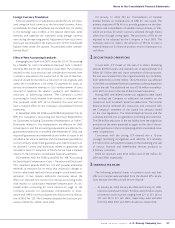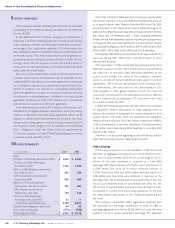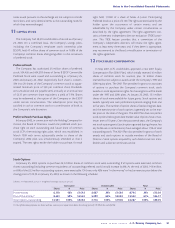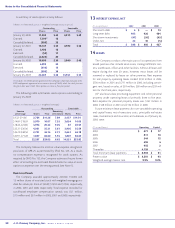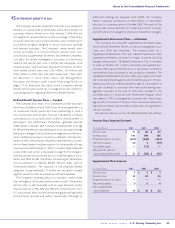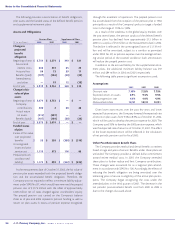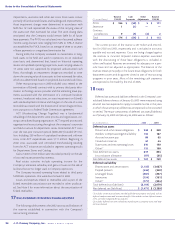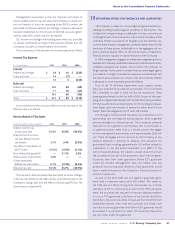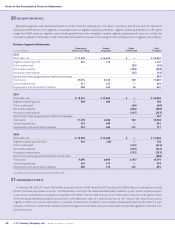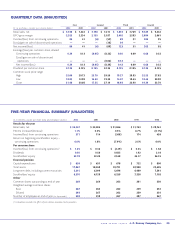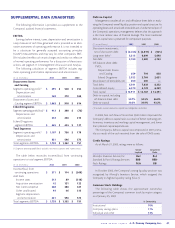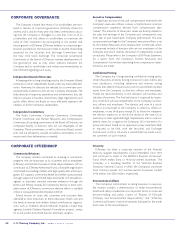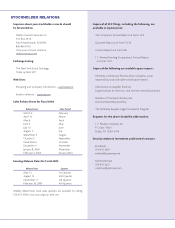JCPenney 2002 Annual Report Download - page 40
Download and view the complete annual report
Please find page 40 of the 2002 JCPenney annual report below. You can navigate through the pages in the report by either clicking on the pages listed below, or by using the keyword search tool below to find specific information within the annual report.
2002 annual report J. C. Penney Company, Inc. 37
Notes to the Consolidated Financial Statements
Management’s assessment is that the character and nature of
future taxable income may not allow the Company to realize cer-
tain tax benefits of state net operating losses (NOLs) within the
prescribed carryforward period. Accordingly, a valuation allowance
has been established for the amount of deferred tax assets gener-
ated by state NOLs which may not be realized.
U.S. income and foreign withholding taxes were not provided
on certain unremitted earnings of international affiliates that the
Company considers to be permanent investments.
The components of the provision for income taxes are as follows:
Income Tax Expense
($ in millions) 2002 2001 2000
Current
Federal and foreign $58$ 10 $ (223)
State and local 14 (7) —
72 3 (223)
Deferred
Federal and foreign 130 68 (68)
State and local 11 18 (27)
141 86 (95)
Tot al $ 213 $ 89 $ (318)
A reconciliation of the statutory federal income tax rate to the
effective rate is as follows:
Reconciliation of Tax Rates
(percent of pre-tax income) 2002 2001 2000
Federal income tax
at statutory rate 35.0% 35.0% (35.0%)
State and local income
tax, less federal income
tax benefit 2.7% 3.4% (2.0%)
Tax effect of dividends on
ESOP shares (4.5%) (3.5%) (1.1%)
Non-deductible goodwill —11.1% 2.6%
Mexico asset impairments 2.6% ——
Other permanent
differences and credits 0.7% (2.3%) (0.4%)
Effective tax rate 36.5% 43.7% (35.9%)
The tax rate in 2002 decreased due principally to recent changes
in the tax law related to the deductibility of dividends paid to the
Company’s savings plan and the effects of adopting SFAS No. 142
(amortization of goodwill).
19 LITIGATION, OTHER CONTINGENCIES AND GUARANTEES
The Company is subject to various legal and governmental pro-
ceedings involving routine litigation incidental to the business. This
includes the Company being a co-defendant in a class action lawsuit
involving the sale of insurance products by a former subsidiary of the
Company. While no assurance can be given as to the ultimate out-
come of these matters, management currently believes that the final
resolution of these actions, individually or in the aggregate, will not
have a material adverse effect on the annual results of operations,
financial position, liquidity or capital resources of the Company.
In 2002, management engaged an independent engineering firm to
evaluate the Company’s established reserves for potential environmen-
tal liability associated with facilities, most of which the Company no
longer operates. Funds spent to remedy these sites are charged against
such reserves. A range of possible loss exposure was developed and
the reserve was increased to an amount that the Company believes
is adequate to cover estimated potential liabilities.
Four of the 10 JCPenney department store support centers
(SSCs) are operated by outside service providers. Two of the three
SSCs scheduled to open in 2003 will also be outsourced. These
openings are planned for the first half of 2003. As part of the oper-
ating service agreement between JCP and the third party providers,
JCP shall assume financial responsibility for the building and equip-
ment leases upon termination of services by either party for any
reason. Potential obligations of JCP total $185 million.
JCP, through a wholly owned subsidiary, has investments in 15
partnerships that own regional mall properties, seven as general
partner and eight as a limited partner. The Company’s potential
exposure to risk is greater in partnerships that it participates in
as a general partner rather than as a limited partner. Mortgages
on the seven general partnerships total approximately $350 mil-
lion. These mortgages are non-recourse to the Company, so any
financial exposure is minimal. In addition, the subsidiary has
guaranteed loans totaling approximately $43 million related to
investments in one real estate investment trust (REIT). In the
event of possible default, the creditors would recover first from
the proceeds of the sale of the properties, next from the gener-
al partner, then from other guarantors before JCP’s guarantee
would be invoked. Management does not believe that any
potential financial exposure related to these guarantees would
have a material impact on the Company’s financial position or
results of operations.
As part of the 2001 DMS sale, JCP signed a guarantee agree-
ment with a maximum exposure of $20 million. This relates to
the 1994 sale of a block of long-term care business by a former
subsidiary of JCP to a third party. As part of the 1994 sale agree-
ment, the purchaser was required to maintain adequate reserves
in a trust. JCP’s guarantee is the lesser of any reserve shortfall or
$20 million. Any potential claims or losses are first recovered from
established reserves, then from the purchaser and finally from
any state insurance guarantee fund before JCP’s guarantee would
be invoked. It is uncertain if, or when, JCP would be required to
pay any claims under this guarantee.


